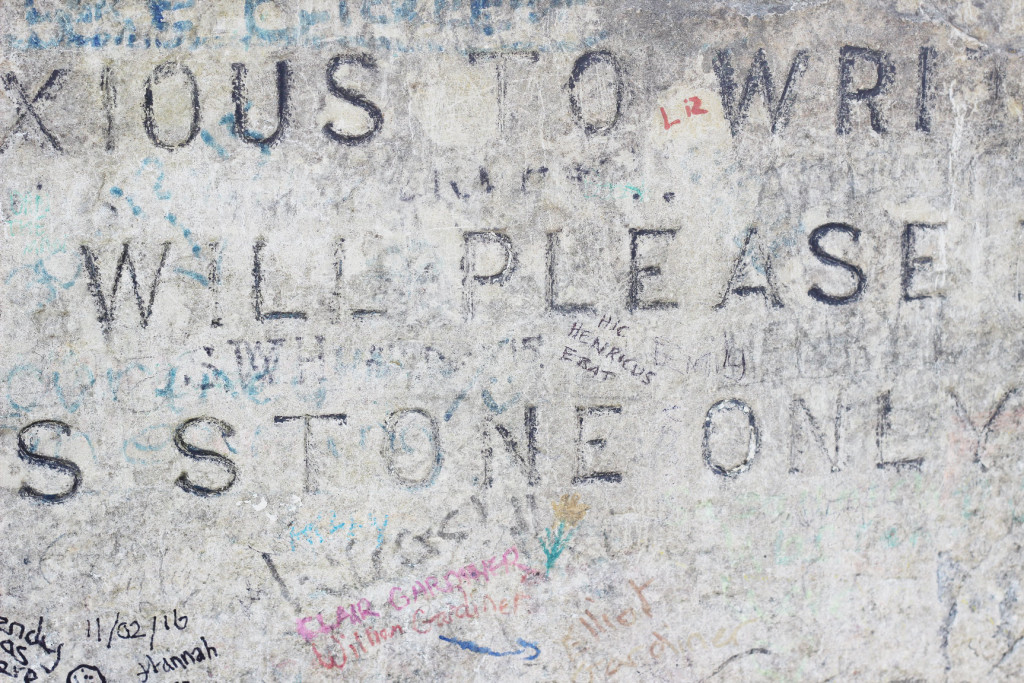I found a few photos of a trip I made back in 2016 to Dorset and thought I may as well post them here. Some research trips just don’t turn out quite how you’d expected. You turn up on a exposed hillside near Swanage expecting a bit of carved Lucretius and… Well, let’s not get ahead of ourselves.
Meet John Mowlem (1788-1868), the son of an impoverished Dorset shopkeeper and sometime quarryman, who established a number of improving institutions in his home town of Swanage. As a lad, he and his family made up one of the last gangs of quarrymen to work the Tilly Whim Quarry, now the caves in Durlston Country Park.
 At 18 John left the Dorset coast for London, finding work at Somerset House in the stamp legacy office. A few years later he secured for himself a job with the highly esteemed London stonemason and sculptor, Henry Westmacott. By 1820 he had set out on his own as a mason and contractor, and began to make a name for himself as a “Footway Stone Contractor”. In 1840 he laid the granite pavement on Blackfriars Bridge in Central London.
At 18 John left the Dorset coast for London, finding work at Somerset House in the stamp legacy office. A few years later he secured for himself a job with the highly esteemed London stonemason and sculptor, Henry Westmacott. By 1820 he had set out on his own as a mason and contractor, and began to make a name for himself as a “Footway Stone Contractor”. In 1840 he laid the granite pavement on Blackfriars Bridge in Central London.
In 1844 Mowlem and his wife retired to Swanage. In 1863 he built the Mowlem Institute, which included a library (with 1450 volumes), a lecture hall and a reading room. He wanted to give the people of Swanage more to do of an evening, and provide an opportunity for further education.
 John Mowlem’s nephew, George Burt (1816-1894), joined his uncle’s business, and soon ran the Mowlem Company’s affairs in London. The two men collaborated on numerous improvements to their hometown, campaigning fiercely for the railway to reach Swanage. After Mowlem’s death, Burt kept the philanthropic flame burning.
John Mowlem’s nephew, George Burt (1816-1894), joined his uncle’s business, and soon ran the Mowlem Company’s affairs in London. The two men collaborated on numerous improvements to their hometown, campaigning fiercely for the railway to reach Swanage. After Mowlem’s death, Burt kept the philanthropic flame burning.
In 1887 Burt had constructed at Mowlem’s stone yard in Greenwich, London, a 40-tonne globe (just over 3m in diameter). This colossal ball of stone still stands proud against the elements on Durlston Head, just below the so-called and much-maligned Durlston Castle. The “castle” — one of Burt’s notorious follies (a strange, crenellated teahouse) has now become home to the Jurassic Coast Heritage Centre.
Burt’s globe was crafted from 15 huge segments of Portland Stone, held together with a granite dowel. Around the globe have been placed various engravings — quotations from Biblical and poetic texts.

Among them, on the Northern edge of the enclosure is a few lines from John Dryden’s translation of Virgil’s Georgics (book 2, lines 475-482):
Give me the ways of wandering stars to know,
The depths of heav’n above and earth below;
Teach me the various labours of the moon,
And whence proceed th’ eclipses of the sun;
Why flowing tides prevail upon the main,
Into what dark recess they sink again!
What shakes the solid Earth; what cause delays
The Summer nights, and shortens Winter’s days.

Perhaps as a nod to Mowlem, who despised graffiti and other forms of “anti-social behaviour”, there is also a stone for “Persons anxious to write their names”. Since I was there primarily to find some Latin inscriptions (maybe Lucretius) that I’d been told stood somewhere near the globe, and only came away with a bit of Dryden’s Virgil – I was anxious to contribute my own learned Latin composition (below the PL_EASE).

